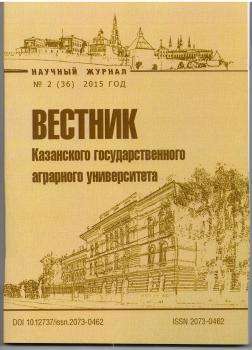Russian Federation
Russian Federation
Russian Federation
Russian Federation
The article deals with the impact of various harmonic vibrations of the musical range on the productivity (yield) of farm animals. Intensification of animal husbandry is impossible without automation and mechanization of production. Along with this, the use of machine milking for cattle (cattle) often becomes another cause of mass animal diseases. For example, mastitis, along with numerous other causes, is often caused by milking machines, which because of their uniformity do not always correspond to both size and shape of the mammary gland of different cows. The relevance of this issue is increasing in connection with the intensification of modern livestock and the replacement of the relationship “man-animal” to the more rigid “man-machine-animal” relationship. At the same time, we must remember that the cow - a creature extremely pedantic, easily irritable, knows its milkmaid well, and it is only necessary to replace this milkmaid with another one, as I immediately begin to fall down. To reduce the stress state of cattle, it is possible to use, for example, classical music, which leads to an increase in the amount of milk in mammals. Together with this, under the influence of rock music, it drops sharply. This influence is explained by the fact that different ranges of acoustic harmonic oscillations resonate with different parts of the brain or organs of the body. We studied the influence of four types of musical works (tracks), differing from each other by the intensity of low, medium and high frequencies. These are works by P.I. Tchaykovskiy, A. Mozart, Indian tracks and works performed on the violin. Studies have shown that there is a difference in the milk yield obtained in the control, as well as in the use of musical works. The greatest effect was obtained using the works of A. Mozart, consisting in increasing the milk yield by 15 ... 18% compared with the control. The carried out technical and economic calculations confirmed the profitability of the proposed measures for the application of harmonic variations in the musical range to increase the productivity of Holstein cows.
musical range of harmonic oscillations, milk yield of cattle, musical tracks.
При машинном доении возможно заболевание до четверти молочного стада. При этом заболеванию подвержены больше высокопродуктивные животные. Заболеваемость животных можно сократить за счет смягчения режима доения, т. е снижения травмирующего воздействия доильного аппарата на вымя коровы. С этой целью были изобретены сначала трехтактные, а затем низковакуумные доильные машины. Вместе с этим известно, что не любая корова пригодна для машинного доения. Например, для промышленной технологии пригодны коровы, у которых интенсивность молоковыделения находится в пределах 1,5…3,5 кг в минуту. Продолжительность доения регулируется гормоном задней доли гипофиза — окситоцином, который сокращает мышечные элементы вымени и таким образом способствует молокоотдаче. Но время его действия в организме коровы ограничено 6…8 минутами, после чего процесс молокоотдачи прекращается. Этим сроком и определяется оптимальная продолжительность доения.
Корова — существо на редкость педантичное и легко раздражимое, она хорошо знает свою доярку, и стоит лишь заменить эту доярку на другую, как удои сразу падают.
У животных хорошо развито чувство времени. Опоздание с дойкой коров на 20…30 минут снижает удои на 5%, а жирность молока — на 0,2…0,4%. Поэтому некоторые английские фермеры монтируют за ушами у коровы — главы стада — небольшой радиоприемник, что позволяет в строго определенное время специально обусловленным радиосигналом вызвать все стадо на дойку [1, 2, 3].
Для уменьшения стрессового состояния КРС можно использовать, например, классическую музыку для увеличения количество молока у млекопитающих животных. Под воздействием рок-музыки продуктивность животных снижается [4]. Биологические объекты – растения и животные предпочитают гармоничную музыку. Например, дельфины с удовольствием слушают классическую музыку, особенно Баха. Акулы, услышав классические произведения, собираются со всего океанского побережья. Растения и цветы под классическую музыку быстрее расправляют свои листья и лепестки. Под звуки современной музыки коровы ложатся и отказываются есть, а растения быстрее вянут [4].
1. Golikov A.N. Adaptatsiya selskokhozyaystvennykh zhivotnykh [Adaptation of agricultural animals], izd. Agropromizdat, 1995g. - P. 76.
2. Kirsanov Yu.A., Simarev, R.F. Filonov “Mekhanizatsiya i avtomatizatsiya zhivotnovodstva”. [“Mechanization and automation of animal husbandry”]. Akademiya, 2004 g. -P. 20.
3. Foldager G., Seyrsen I. Biokhimiya laktatsii. [Biochemistry of lactation], izd. Mellkor, 2000 g.
4. Vliyanie muzyki na zhivotnykh i rasteniya. (The influence of music on animals and plants). Available at: http://www.liveinternet.ru/users/1758119/post62010904 . Data obrashcheniya 25.04.2018.
5. Effekt Motsarta. (The Mozart effect). Available at: https://www.sunhome.ru/psychology/15190. Date of access 25.04.2018
6. Kondrateva N.P., Markov D.A., Kondrayev R.G.Vliyanie muzykalnykh zvukovykh kolebaniy na nadoi korov Golshtinskoy porody. V sbornike: Biotekhnologiya. Vzglyad v buduscheye. Materialy III Mezhdunarodnoy nauchnoy Internet-konferentsii: v 2 tomakh. (The effect of musical sound vibrations on the milk yield of Holstein cows. In the collection: Biotechnology. A glance at the future. Proceedings of III International Scientific Internet Conference: in 2 volumes). Sostavitel D.N. Sinyaev. 2014. - P. 104-105.
7. Kondrateva N.P., Markov D.A., Kondrateva M.G. Vliyanie garmonicheskikh kolebaniy muzykalnogo diapazona na nadoi korov Golshtinskogo porody. V sbornike: Aktualnye problemy energetiki APK. Materialy V Mezhdunarodnoy nauchno-prakticheskoy konferentsii. (Influence of harmonic oscillations of the musical range on milk yields of Holstein cows. In the collection: Actual problems of power engineering of the agroindustrial complex. Proceedings of V International scientific and practical conference). Pod redaktsiyey V.A. Trushkina. 2014. P. 165-168.





